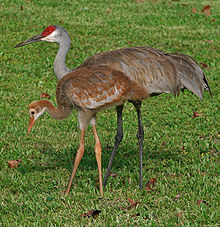Cranes are an ancient family of birds. Scientists
and archaeologists assume that cranes performed their courtly dance in the
steamy primeval wetlands around 60 million years ago. The elegant birds are
still strutting around today.
Cranes have long legs, long necks and are tall with
grey or white feathers and patchy red face markings. Their groups are
Gruiformes and include rails and bustards. They are very much like herons but
bigger and in flights hold their neck stretched out – unlike herons. Cranes
nesting on the ground and do not spend a lot of time in the trees as herons but
the crowned crane roost in the trees.
Although shy, wary and always alert they are
sociable birds. They live in a group and pairing up during breeding season.
Cranes mate for life and the male helps to hatch and rear the offspring.
Most cranes are migrating birds. They long trips
between winter feeding grounds and breeding areas. They fly in squadrons, in
V-formed, and are very noisy when they fly. Their loud cries can be heard for
many kilometres due to their long windpipe.
==================================================
PLEASE BE SO KIND AND CLICK ON ADVERTS. THANK YOU.
===================================================
==================================================
PLEASE BE SO KIND AND CLICK ON ADVERTS. THANK YOU.
===================================================
The common crane measures up to 1.2m and has a
wingspan 1.5m. The plumage is ash-grey but the forehead, nape, throat, flight
and tail feathers are black. On the top of its head is a crimson patch. The adult male crane has a ‘cock’s tail’
which is a bunch of long feathers drooping over its tails. To display their
beauty it raises these feathers.


European cranes start migrating in August and their
majority in October and November flying at a speed of 50km/h. The majority
over-winter in India and Africa and return in February and March.
 |
| SARUS CRANE |
The sarus crane is the tallest flying bird. It can
reach a height of 2m. They can be seen strutting along roadsides. They are
sacred birds in Northern India and therefore quite numerous.
The sandhill crane is greyish and often speckled with reddish brown spot which were caused by the bird’s bill picking up mud and spread when preening its feathers.
Demoiselle cranes are mostly small and have beautiful whitish tuft of feathers on their neck and black plumes on their chest. They migrates large numbers such as thousands of birds and crossing the Himalayas or other mountain ranges


The black crowned crane living in tropical Africa
and has a magnificent plumage. A black velvet cap, magnificently crown of
straw-coloured bristly feathers, a red throat wattle and bar pink and white
checks is describing its beauty. Their closed relative is the grey crowned
carne and has a trumpeting very loud cry. Another species which was saved from
extinction by conservationists is the whooping crane and therefore a very rare
bird.
Cranes did not establish themselves in South
America. The only relative species is the limpkin. It has the distinctive
limping gait of a crane and a melancholy wailing. It lives throughout American
wetlands hunting big snails.




No comments:
Post a Comment